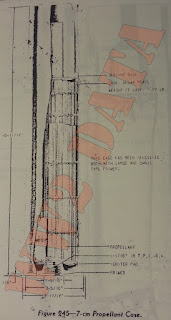Introduction to Army 7cm (75mm) Ammunition
There were ten or more 75mm guns in use in the Japanese Army. Though the weapons vary considerably in design, length of bore, and employment, the bore diameter (75mm) is held constant and in large part the projectiles are designed to be interchangeable for numerous guns. In this way, identical projectiles may be assembled with different sizes of case and propellant charges to fit the various weapons.
For this reason the cases and propellant charges for the different weapons will be treated separately and the projectiles will be presented as a group of designs which are potentially interchangeable for all Army 75mm guns. The specific purpose of a given projectile or a given gun will limit the occurrence of many of the possible combinations.
Ammunition for Japanese Navy guns designated "8cm" is comparable in size to Army 7cm, but the Navy guns have a bore diameter of 3 inches (76.2mm) and Army and Navy projectiles and ammunition are not interchangeable. Navy guns as well as Army guns are found commonly in shore defenses, but the identity of the installations, weapons, and ammunition remains distinctly Army or Navy.
*: For convenience in reference, this group, in which the propellant cse bears the multiple designation for four weapons, will be termed "Type 38 Field Gun Group"
7cm (75mm) H.E.A.A. Projectile
Note - The drawing given here is based on a Japanese drawing labelled only "Circular-layered projectile". The projectile is of apparent 75mm size and the body appears to be made up of numerous steel rings bolted together with several bolts which are grooved at intervals to produce better fragmentation.
This projectile is believed to be the same referred to in other documents as "H.E.A.A. Projectile" for the Type 11th year field A.A. gun. The following applies only if this presumption is correct.
Weight of projectile, filled and fuzed: 6.60kg
Filling: "ONA", a mixture of picric acid and dinitronaphtalene
Fuzing: Type 10th year A.A. powder time fuze
Used in: Type 11th year field A.A. gun
Type 90 7cm (75mm) H.E.A.A. Long Pointed Projectile
Weight of projectile, filled (TNT): 6.53kg
Weight of filled: 0.385kg
Filling:
-Standard: TNT cast directly into lacquered cavity (Recovered)
-Alternate: Picric acid (Documentary evidence)
Diameter at bourrelet: 75mm
Length overall (w/o fuze): 257mm
Length of projectile from case: 202mm
Width of forward rotating band: 9.5mm
Width of after rotating band: 9.5mm
Width of space between rotating bands: 6.5mm
Width of copper bourrelet: 14mm
Distance from base to after edge of bourrelet: 140mm
Fuzing: Type 89 long pointed powder time fuze in nose. An auxiliary fuze armed by setback and centrifugal force is used immediately below the time fuze
Type 90 7cm (75mm) H.E. Long Pointed Projectile
Weight of projectile, filled (w/o fuze) (TNT): 6.17kg
Weight of filling: 0.49kg
Filling:
-Standard: TNT cast directly into a lacquered cavity (documentary)
-Alternate: "HEINEI" trinitrophenetole (recovered)
Indicated by painted on body
Diameter at bourrelet: 75mm
Length overal (w/o fuze): 317.5mm
Length protruding from case: 267mm
Width of rotating bands:
-Upper: 10.6mm
-Lower: 9.6mm
Fuzing: Type 88 instantaneous (Gun), Type 88 delay (Gun)
Operation and employment:
It is believed this projectile was designed primarily to adapt the Type 88, 75mm high velocity A.A. gun to a dual-purpose field gun (IE: for air and ground targets). The ballistic form of this projectile approximates that of the Type 90 long pointed A.A. projectile, when the A.A. time fuze is installed. The projectile is also used for other weapons as listed below.
Used in:
-Type 88 field A.A. (Special), case 19 and 3/16 inches
-Type 38 field gun group (four weapons), case 11 and 9/16 inches
-Type 90 field gun, case 16 and 11/16 inches
-Type 94 mountain gun
Remarks:
When this projectile is cased for use in the Type 88 field A.A. gun (special), a reduced propelling charge is used. This reduced charge is indicated by a Roman numeral II stenciled on the case.
Type 94 7cm (75mm) High Explosive Projectile
Weight of projectile, filled (TNT): 6.02kg
Weight of filling: 0.81kg
Filling:
-Standard: TNT cast directly into lacquered cavity
-Alternate (1): "ANGA" ammonium nitrate, RDX
-Alternate (2): "HEINEI" trinitrophenetole
Diameter at bourrelet: 75mm
Length overall (w/o fuze): 303mm
Length protruding from case: 264mm
Width of rotating band: 10mm
Fuzing: Type 88 instantaneous fuze (Gun), Type 88 short delay nose fuze (Gun)
Used in:
-Type 41 mountain gun (regimental gun), case 7 and 1/4 inches
-Type 94 mountain gun, case 11 and 3/16 inches
-Type 38 field gun group, case 11 and 9/16 inches
-Type 88 field A.A. gun, case 19 and 9/16 inches
-Type 88 field A.A. (special) gun, case 19 and 9/16 inches
-Type 90 field gun, case 16 and 11/16 inches
Remarks:
Two other designs essentially the same as Type 94 are known:
1. H.E. Type 10 year.
2. H.E. Type 90.
These have the same overall length as the Type 94, and have the same external form and general construction except for the following features.
1. The explosive cavity does not taper in the base as in the Type 94, but is straight-sided.
2. The slight boat tail present on the Type 94 is absent in the other designs.
3. Below the rotating band in the Type 10 year designs only, there is an annular groove into which the case is crimped.
Next Time: More 75mm Projectiles












No comments:
Post a Comment